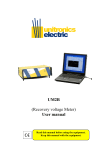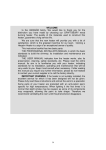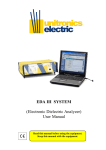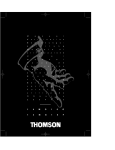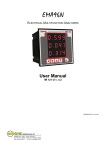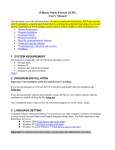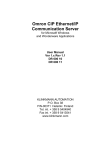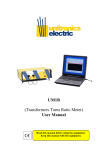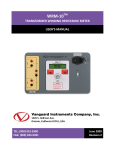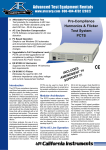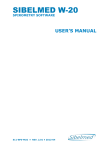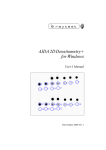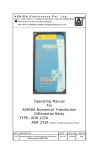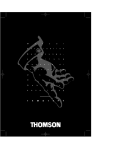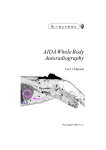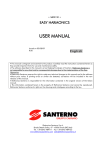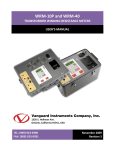Download Manual de la UM-3 - Unitronics Electric
Transcript
ETP SYSTEM UM3B (Transformer Winding Resistance Tester) User Manual Read this manual before using the equipment. Keep this manual with the equipment. Avenida de la Fuente Nueva, 5 28709 San Sebastián de los Reyes Madrid (SPAIN) Tel.: +34 91 540 01 25 Fax: +34 91 653 98 10 www.unitronics-electric.com INDEX INDEX PROLOGUE _____________________________________________________________ 3 SYSTEM OF SYMBOLS ___________________________________________________ 4 GUARANTEE ____________________________________________________________ 5 1.- INTRODUCTION ______________________________________________________ 6 2.- DESCRIPTION OF MEASURING METHOD _______________________________ 8 2.1.- Philosophy of measuring method __________________________________________ 8 2.2.- Test characteristics _____________________________________________________ 9 3.- UM3B EQUIPMENT___________________________________________________ 10 3.1.- Product description ____________________________________________________ 10 3.2.- System components ____________________________________________________ 12 3.3.- Physical description of the equipment _____________________________________ 18 4.- PREPARATIONS BEFORE USE ________________________________________ 21 4.1.- Precautions in installation area __________________________________________ 22 4.2.- Connection of equipment _______________________________________________ 24 4.3.- Equipment disconnection _______________________________________________ 28 5.- SOFTWARE DESCRIPTION ____________________________________________ 29 5.1.- Introduction __________________________________________________________ 29 5.2.- Hardware key. Configuration menu. ______________________________________ 31 5.3.- Test performance ______________________________________________________ 33 5.3.1.- Test identification_______________________________________________________ 35 5.3.2.- Transformer technical data ________________________________________________ 39 5.3.3.- Measurement configuration _______________________________________________ 42 5.3.4.- Connection ____________________________________________________________ 45 5.3.5.- Measurement __________________________________________________________ 47 5.4.- Test analysis __________________________________________________________ 58 5.4.1.- Test file selection _______________________________________________________ 59 5.4.2.- Transformer technical data ________________________________________________ 61 5.4.3.- Measurement tables _____________________________________________________ 63 5.5.- Test repetition assistant _________________________________________________ 66 5.6.- Remarks page _________________________________________________________ 67 -1- INDEX 5.7.- Printing reports _______________________________________________________ 68 5.8.- About…______________________________________________________________ 72 5.9.- Exiting _______________________________________________________________ 73 5.10.- Other error messages. _________________________________________________ 74 6.- EQUIPMENT MAINTENANCE _________________________________________ 76 6.1.- Cleaning of equipment _________________________________________________ 77 6.2.- Care for cables ________________________________________________________ 78 6.3.- Check of high current cables ____________________________________________ 79 6.4.- Fuse replacement ______________________________________________________ 81 6.5.- Storage and transport __________________________________________________ 82 7.- TROUBLESHOOTING _________________________________________________ 84 8.- TECHNICAL SUPPORT________________________________________________ 87 8.1- Return for calibration/repair _____________________________________________ 88 8.2.- Requests for spares ____________________________________________________ 91 8.3.- Observations __________________________________________________________ 91 8.4.- Authorized technical representatives and services ___________________________ 94 9.- SPECIFICATIONS ____________________________________________________ 95 APPENDIX A.- “CE” CONFORMITY DECLARATION ________________________ 98 APPENDIX B. - SYSTEM REQUIREMENTS _________________________________ 99 APPENDIX D.- CONTROL SOFTWARE INSTALLATION _____________________ 100 APPENDIX D.- OTHER UNITRONICS EQUIPMENT ________________________ 101 D.1.- Applications available_________________________________________________ 102 APPENDIX E.- GLOSSARY ______________________________________________ 107 -2- PROLOGUE PROLOGUE The user manual contains all the information required to start up and maintenance of the UM3B measurement system. Its objective is to provide everything needed for successful operation. IMPORTANT: Read the instruction manual fully before starting up the UM3B unit. The information contained in this manual is intended to be as exact as possible. Nevertheless, UNITRONICS shall accept no responsibility for direct or indirect damage caused by incorrect interpretation, inaccuracies or omissions in the manual. -3- SYSTEM OF SYMBOLS SYSTEM OF SYMBOLS DANGER: This symbol indicates a highly hazardous procedure, which might cause serious damage to equipment or people, possibly even death, if not performed properly. WARNING: This symbol indicates a hazardous procedure that might cause serious damage to equipment or people, if the appropriate precautions are not taken. UNITRONICS, S.A.U. is an ISO9001 certified company. The equipment meets the requirements of the EU Directives. UM3B Transformer Winding Resistance Tester User Manual January, 2013 ( Eighth Edition) UM3B_User_Manual_V8_0CE.doc Copyright 2013, UNITRONICS, S.A.U. All rights reserved. No part of this manual may be reproduced without authorization. The contents of this manual may change without prior notice. -4- GUARANTEE GUARANTEE All the equipment produced by UNITRONICS is covered by a standard guarantee of 12 months as from de date of delivery to the client. The guarantee is against material and workmanship defects. UNITRONICS obligation covers the repair or replacement of faulty products throughout the guarantee period. The guarantee covers the equipment but it is not applicable to accessories, cables, etc.. In order to benefit from the guarantee, the purchaser should notify UNITRONICS or its nearest representative of any defects prior to expiry (see section 8) of the guarantee period. This guarantee does not cover defects, faults or damage caused by incorrect use or inadequate maintenance by the purchaser, or unauthorized modifications or use outside the specifications. Neither does the guarantee cover faults caused by natural disasters, including fire, flooding, earthquakes, etc. Any opening of the equipment, modification, repair or intent to repair performed without authorization shall invalidate this guarantee, which shall automatically be cancelled in such cases. This guarantee shall be effective only for the original purchaser of the product, and is non-transferable in the event of resale. Guarantee extensions and maintenance contracts are available for both the hardware and software. Please request information from the sales department of the nearest representative (see section 8). -5- 1.- INTRODUCTION 1.- INTRODUCTION Gaining insight into the status of transformers is a complex problem. Different techniques have been developed for this purpose, allowing in-depth studies to be made of the different parts into which a transformer may be divided. One of the methods used consists of measuring the resistance of the transformer windings, through which problems may be detected, such as: loosening of connections defects in the regulators short-circuiting between turns hot points in winding Nearly all these methods show a peculiarity: the absolute values of the measured parameters tend not to be sufficiently indicative for the results to be evaluated, their evolution providing better information on winding status. Therefore, it is interesting to store the results and incorporate them into databases allowing them to be correlated. This leads to the definition of a predictive maintenance policy, consisting of scheduling, with a suitable frequency, the performance of a series of routine and easily performed tests that, through the analysis of certain parameters, provide enough information on the evolution of the whole. When this analysis detects rapidly evolving situations, or when values which might on average be considered hazardous are reached, other more complex testing techniques are applied, these possibly implying the unavailability of the machine over long time periods, or even the possible existence of certain risks to winding integrity. The objective of this type of maintenance is to gain an accurate insight into the actual status of an item of equipment or a component and, depending on this status, to determine the best course of action: continue with normal operation, impose certain limitations, carry out an overhaul or repair or, finally, undertake replacement. In other words, the aim is not only to limit unnecessary actions but also to complete the level of information available on the actual status of the equipment, such that a suitable decision may be taken. Predictive maintenance is applied with greatest success, and most frequently, to major items of equipment subject to complex phenomena of ageing or degradation and involving a large number of variables. In most of these cases there are no formulas allowing the status of the equipment to be estimated, as a result of which it is necessary to perform tests to obtain the values of different significant parameters and, on the basis of these values, make an interpretation. -6- 1.- INTRODUCTION Consequently, their start-up is linked to the definition and performance of tests and to the interpretation of their results. For the first of these tasks, it is essential for there to be indepth knowledge of the equipment and the techniques involved, and for the second that specialist technical personnel be available. There are software applications that can help very much to the responsible of equipment evaluation in the interpretation of results: "Trends Evolution" and "Expert Diagnostic System" (see appendix C) but the final determination is in the hand of the responsible and overall will come given of the hand of the experience. -7- 2.- DESCRIPTION OF MEASURING METHOD 2.- DESCRIPTION OF MEASURING METHOD 2.1.- Philosophy of measuring method The UM3B system is an automatic system especially designed to carry out lowresistance measurements on transformer windings. It is designed for use as a predictive maintenance system, for which it meets the following requirements: Automatic measuring system. For the prevention of errors due to acquisition, handling and correction times resulting from the environmental and machine conditions at the time of measuring. Repeatability of measurements. This guarantees that the readings performed over a period of time have been obtained in the same way and with the same degree of accuracy and tolerances. This allows the study of the evolution of such measurements. Automatic, organised storage of results. This greatly simplifies the handling of the large amount of information obtained. Updateable system. Developed such that new software developments may be implemented as they arise using the same items of hardware. Acquisition of key parameters. This automatically calculates a list of parameters and graphics for diagnosis of machine status. Non-destructive testing. If handled properly, there is no risk of damage to the insulation during testing. -8- 2.- DESCRIPTION OF MEASURING METHOD 2.2.- Test characteristics The objective of the test is as follows: It should be simple to perform and, to the extent possible, should allow for performance by duly trained facility personnel, without the need for specialists to be present. It should not imply any risk for the equipment to be tested. It should not imply excessive unavailability (none if possible). The data and results obtained should provide at least some information that may be immediately interpreted by the operator carrying out the test. It should be possible to store the set of data obtained on computer media, such that it may be easily sent and a more detailed studied by specialists, who will obtain the maximum information from the data acquired and take the appropriate decisions through comparative studies against other cases. -9- 3.- UM3B EQUIPMENT 3.- UM3B EQUIPMENT 3.1.- Product description The UM3B Low-Resistance Ohmmeter is especially designed for the measurement of the resistance of transformer windings and single and/or three-phase autotransformer of any variety. However this equipment is also suitable to pure ohmic resistance and windings resistance of rotating machine measurements. It is in the measurement of three-phase transformer windings, however, where the full power of the equipment is shown, since in a single test it provides the simple and compound resistance value for each winding: both high and low voltage and tertiary. Furthermore, to calculate the results, the system takes into account the transformer connection group, and the temperature at which the test is carried out, as such results are provided at the reference temperature specified by the operator. Figure 3-1: Photograph of UM3B equipment. - 10 - 3.- UM3B EQUIPMENT The equipment is based on the measurement of simple parameters using a data acquisition system and a computer application for calculation performance. The measurement technique used is the metric ratio resistance method (measured on four wires), as this technique presents a series of advantages, such as: immunity against the variations in the values of the measuring circuit components immunity against temperature changes immunity against variations in test current Once the data is obtained, there is enough information to make diagnoses about the current status of the transformer and evaluate the trend curves. The advantages that characterize the UM3B method can be summarized as follows: minimum risk for the machine reduced unavailability periods simple performance high degree of test automation - 11 - 3.- UM3B EQUIPMENT 3.2.- System components The following elements and accessories might be available with the equipment: NOTE: The XX nomenclature indicates different versions, depending on the characteristics of the equipment. Please consult with your sales person. REF. NO. UM3BXX00 DESCRIPTION UM3B measuring equipment with serial number Figure 3-2: Photograph of unit. BEL00 Transportation bag for the measuring equipment - 12 - 3.- UM3B EQUIPMENT Figure 3-3: Photograph of transportation bag. CR00 CRS23200 Mains supply cable with earth Shielded serial cable with DB9 terminal communications between the PC and the unit. connectors Figure 3-4: Photograph of the serial cable (RS232). - 13 - for 3.- UM3B EQUIPMENT UM3M80M 8-metre cable-hose with end clamps. Each cable in the hose has a different colour (blue, yellow or red). The biggest clamp (of the strongfastening kind) is for current and the smallest (of a clip-type) is for voltage. Figure 3-5: Photograph of connection cable hose. BCL00 Cable transportation bag. - 14 - 3.- UM3B EQUIPMENT Figure 3-6: Photograph of cable transportation bag. SOFUM3BXXWXXX 1 USB Pen Drive containing the equipment control software UM3BMUXX The current user manual UM3P120M 12-meter extension cable for the connection cable-hose. - 15 - 3.- UM3B EQUIPMENT Figure 3-7: Photograph of cable hose extension. RAFVDM00 Mains strip with four power sockets protected against transient voltages, differential currents and overcurrent conditions. It incorporates a voltmeter for the direct verification of the power voltage and terminals for ground connections. - 16 - 3.- UM3B EQUIPMENT Figure 3-8: Photograph of connection strip. MM01 Rigid transport case with reinforced external protection and interior cushioned with high-density foam rubber. Figure 3-9: Photograph of transportation case. - 17 - 3.- UM3B EQUIPMENT 3.3.- Physical description of the equipment Figure 3-10 includes a drawing of the UM3B unit, the upper part being the front panel and the lower the rear panel. The function of each of the unit elements is described below. Power Comm. 1 8 2 3 MODEL: SERIAL Nº: Vin: VA max: FUS: 4 5 6 7 Figure 3-10: Explanatory diagram of UM3B unit. 1 Cable hose connector for performance of measurement of the equipment being tested. 2 Power-on light. This should light up when the connection switch (3) is activated. - 18 - 3.- UM3B EQUIPMENT 3 Communications LED. While this is communication between the unit and the PC. lit, there is 4 Power-on switch. This is activated to connect the equipment to mains when the PC software indicates that this should be done. 5 Mains input connections socket. Includes a fuse holder and spare fuse. 6 Fan cooling of unit. 7 PC communications connector. 8 Plate with characteristics of unit. A hose that ends in three cables (blue, yellow and red) complements the UM3B. There are two clamps for each cable, which are connected to the corresponding terminal of the equipment being tested: one for current (thicker), which is responsible for injecting the current into the winding; and the other for voltage (thinner), which is for measuring the voltage at the terminal. Voltaje clamp Current clamp Figure 3-11: Detail of cable-hose clamps. - 19 - 3.- UM3B EQUIPMENT The old clamps of current have been replaced in new hoses by a much more appropriate for the work in bushings of all type of power transformes. Now their fixation is safer, trustworthy and less harmful. In addition, the new clamp (to see previous figure) is able to include greater bushings. The rest of the indicators/warnings appear on the computer screen, and will be described in detail in chapter 5 (Software description). - 20 - 4.- PREPARATIONS BEFORE USE 4.- PREPARATIONS BEFORE USE The UM3B equipment is a high performance automatic system specialized in measurement of winding and regulator set resistance (if applicable). To perform this measurement, the system uses the four-wire method, injecting a current signal of up to 20 Amperes. These currents may induce high voltages in the tested equipment if the connection with the unit is interrupted for any reason. This may cause serious danger to the operator if the manipulation is carried out of specifications. Consequently, IT IS ESSENTIAL THAT THE OPERATOR IN CHARGE OF HANDLING AND MAINTAINING THE EQUIPMENT BE TECHNICALLY TRAINED. Likewise, all persons performing or attending a test should take the necessary safety precautions to avoid any contact with the parts to be analysed or forming part of the measuring system, remaining at some distance from them, unless these parts are free from voltage and grounded. The measurements performed using the UM3B system are OFFLINE Therefore, before beginning the test, A CHECK MUST BE MADE TO ENSURE THAT THE SYSTEM IS WITHOUT VOLTAGE. If the equipment is damaged during the guarantee period as a result of inappropriate use, without adhering to the indications given in this chapter, the repairs may be excluded from the guarantee. - 21 - 4.- PREPARATIONS BEFORE USE 4.1.- Precautions in installation area When this instrument is used to check high voltage machines, all the safety procedures and standards normally applied to this type of machinery must be taken. In any case, check that the equipment being tested is completely discharged and grounded before touching it. In order to ensure the safety of the equipment operators or any other worker in the immediate area, and the integrity of the system itself and validity of the measurement results, a series of precautions should be taken in the place where the test is going to be performed. These can be summarised as follows: Check that the environment is appropriate (without rain or dust storms) and within the temperature/humidity ranges specified for operation (see chapter 9: Specifications). Check that the power voltage is within the specified operating limits (see chapter 9: Specifications) and that it has grounded connection; this ground should match with the one of the equipment being tested. If not sure, the best thing is to connect a thick twisted mesh grounding cable from the system power source to the equipment being tested. Check that no voltage is connected to the equipment to be tested. Place the measuring unit and the control computer near the equipment to be tested, as shown in Figure 4-1. Set adequate warnings indicating your work. Isolate the area where the equipment is being tested by means of the mechanical safety elements homologated by the safety departments of each company, such as cones, enclosures, safety bands with coloured safety warnings at waist height, etc. The equipment is intended for functioning with a thermal limit with relation to the disipation of the supply energy during the tests so do keep in mind the next warnings: - 22 - 4.- PREPARATIONS BEFORE USE ROOM TEMPERATURE: The equipment only will be used within limits specified of operation: 5ºC... 35º. REFRIGERATION: For the resistance measurement, the process since the magnetization begins until a resistance valid value is obtained, it cannot last more than 15 minutes in the scales of current of 20 amperes, being necessary a time of rest of 1 minute, so that this process is made again (for example hoping between positions of regulator to measure the 3 phases again). Once finished all the tests, unit must recover the suitable temperature with his system of refrigeration during 3 minutes before switching off. WARNING: In the resistance measurement, the process from the start of magnetization until obtain a correct value, this time can’t be bigger than 15 minutes, being necessary a minimum time of rest of 1 minute for new process to start. For example waiting between steps of regulator for a new measurement of the three phases. Don't obstruct the entrance of ventilation of the unit neither the perforated lateral panels (6). If is observed that the ventilator is broken or turn with difficulty, don’t make a new test because the equipment could be result damaged. - 23 - 4.- PREPARATIONS BEFORE USE 4.2.- Connection of equipment Due to the potential danger implied by this equipment, IT IS NECESSARY TO FOLLOW THE SEQUENCE DESCRIBED For the performance of tests, the measuring unit and the control computer should be located close to the equipment to be analysed, as indicated in Figure 4-1. To start up the equipment, the following instructions should be followed, in the order indicated (references are included in brackets to the different elements on the panels in Figure 3-10): Figure 4-1: Explanatory diagram of the interconnection of components for a test. - 24 - 4.- PREPARATIONS BEFORE USE - Connection of PC to UM3B This is accomplished by means of the serial/USB conversor cable provided, with DB9 connectors (7). Cable must be shielded. - Safety check A check should be made to ensure that the equipment to be measured is fully isolated from the external supply and fully discharged. - Connection of the cable hose to the UM3B The cables should first be connected to the unit (1), and the clamps then left in the area near to the equipment being tested to be connected later according to the sequence indicated by the software. V maxim: 24 V I maxim: 20 A Installation: CAT II - Connecting UM3B equipment to the mains This connection is accomplished by plugging the power cable input (5) to a mains socket. A check should be made to ensure that the voltage is within the operating limits (see chapter 9: Specifications) and that the socket has a ground connection. - Connection of power to PC The PC power cable is plugged into a mains socket. A check should be made to ensure that the voltage is within the operating margins of the PC Once the different connections between the different parts of the equipment have been performed, the PC should be turned on and the control software started. From now on the procedure consists simply of following the instructions that appear on the PC monitor. Consequently, when the software so requires, the UM3B unit will be turned on (4). THE UNIT SHOULD NOT BE TURNED ON UNTIL THE CONTROL SOFTWARE INDICATES THIS. - 25 - 4.- PREPARATIONS BEFORE USE As the program so requests, the hoses leading to the equipment being tested will be handled in the required way. Special care must be taken when connecting each of the hoses (according to their different colours) to the phases indicated by the program. The colours assignment to use for distinguish the phases in three-phase transformers correspond with: Red phase U, Yellow phase V and Blue phase W. In the case of singlephase transformers the correspond will be: Red phase X1 and Yellow phase X2. The black terminal correspond with the neutral and is not used for the unit in the measurement, only there is for compatibility with others units. Furthermore, at the accessible terminal of the transformer, the voltage terminals must ALWAYS be below the current terminals (see Figure 3-1, Figure 4-2 and Figure 43) in order to avoid any influence by the contact resistances on the measurement. Fastening will be both secure and safe in order to minimize contact resistance between the clamps and the connection terminals on the equipment being tested. Likewise, the areas where the current and voltage clamps are connected (contact areas) should be free from dust, oxides, etc., such areas having been sanded if necessary. An special attention in the hoses connection: in that contact doesn't exist between the current and voltage clamps, to avoid possible erroneous measures WARNING: If the equipment is used outside manufacturer’s specifications, the security could be altered. WARNING: When the program indicates it, connect first all the current clips and next all the voltage clips in correspond of your colours to the phases indicated. DURING THE MEASUREMENT: Never remove the cables during the measurement nor change the position of transformer’s regulator because this could open the circuit. The supply connection of the equipmet should be reliable because an interruption during the test could damage the equipment. - 26 - 4.- PREPARATIONS BEFORE USE I1 I2 V1 I1V2 R V1 R V2 I1 I2 Figure 4-2: Explanatory diagram of correct four-wire measurement performance. Figure 4-3: Photograph of cable hose to winding connection. WARNING!: DURING THE TEST, THE CLAMPS MUST NOT BE TOUCHED OR DISCONNECTED, SINCE THE VERY HIGH CURRENT CIRCULATING MIGHT CAUSE A STRONG PEAK AND DAMAGE TO THE OPERATOR AND EQUIPMENT. - 27 - 4.- PREPARATIONS BEFORE USE 4.3.- Equipment disconnection WARNING!: The cables must be handled with maximum care, as they carry large currents and high inductances, which may produce highvoltage transients. Thus, the normal safety measures for high-voltage installations should be taken into account. After testing each winding, the equipment will then demagnetise it. Therefore, the UM3B unit will turn it off when the control software specifies that the measuring has finished. In transformers of more than 20MVA, discharging may take several minutes. Thus, it is good safety practice to use rubber gloves for handling the connection clamps. Once requested by the program, the UM3B unit will be disconnected according to the following steps: - Turn off the UM3B. - Remove all the voltage clamps before the current clamps from the equipment being tested. - Remove the UM3B hose. ALWAYS REMOVE ALL VOLTAJE CLAMPS BEFORE THE CURRENT CLAMPS WHEN REMOVE THE CABLES. - 28 - 6.- EQUIPMENT MAINTENANCE 5.- SOFTWARE DESCRIPTION 5.1.- Introduction Along with other units with their respective applications (se Appendix C), the UM3B forms a system for the testing and analysis of electrical machinery. Therefore, all these applications are triggered from a common application named "Electrical Machinery Testing and Analysis System" (Figure 5-1), which is found in the folder of the same name in Start Programs. Figure 5-1: TEST AND ANALYSIS SYSTEM OF ELECTRIC MACHINES menu screen. This screen shows all the tests, which may be performed on the different machines and/or components. If any of the options is shown as being disabled, it is because the client does not posses the corresponding application, which may be acquired at any time (see chapter 8 and appendix C). - 29 - 6.- EQUIPMENT MAINTENANCE In this case, the tab "POWER TRAFO" or "MEASUREMENT TRAFO", or the corresponding icon in the upper section, should be selected. Then the user presses the icon that corresponds to the UM3B, triggering the said program (Figure 5-2). This basically offers two optional ways of functioning: - Test performance (Test) - Results analysis (Analysis) Figure 5-2: Main UM3B program menu. For test performance, a series of machine ID data is needed, which the operator must provide. Later, It will be possible to perform an analysis of the results based on the voltages measured and on a series of calculations. Also provided is a series of utilities, such us a file copying assistant or a log for the noting down of test or analysis events. If the PC lacks the corresponding security key connected , the possibility of performing tests will be disabled. It will be possible to run analyses only on previous tests. - 30 - 6.- EQUIPMENT MAINTENANCE 5.2.- Hardware key. Configuration menu. The first step to carry out before executing the application, is to place the USB Dongle supplied in a USB port of the PC. In the case of not connecting it, the software will only allow you to carry out analysis of test already performed. When you connect it, you will be able to carry out test. For system configuration, click on "Config" button. Sucessively, the following menu will appear (Figure 5-3), in which one will choose the after parameters of the system: Figure 5-3: Configuration Screen. - Control: RS-232, in the case of that the communication of the PC with the unit is performed by means of the serial port. You will need to indicate which port will be used, (COM1- COM4), by means of the existent ring. - 31 - 6.- EQUIPMENT MAINTENANCE - Supply: First of all you will need to select the mains voltage, that will be 115 or 230 V. The frequency of mains voltage will also need to be selected, which will be 50 or 60 Hz, by means of the corresponding ring. - Language: Select one of the languages that are listed. Once selected, after finishing the program configuration, all the text of the application will change to the selected language. - Date: The format of the date will be elected, be it day - month - year (DD-MM-AAAA), or month- day- year (MM-DD-AAAA). - Temperature: Select the units used in the temperature; Fahrenheit (ºF) or centigrade (ºC). - Topology: U – V - W. Select the nomenclature of the connection, be it, A – B - C or Once the system is configured, press OK button to accept chosen configuration, or CANCEL, if you choose to refuse it. - 32 - 6.- EQUIPMENT MAINTENANCE 5.3.- Test performance The measurements performed using the UM3B system are OFF-LINE. Consequently, before beginning the test, A CHECK MUST BE MADE TO ENSURE THAT THE SYSTEM IS WITHOUT VOLTAGE. Before starting the test, the UM3B must already be connected to the PC by means of a flat cable, but THE UNIT MUST NOT BE TURNED ON UNTIL REQUESTED BY THE SOFTWARE. Consequently, no operation should be performed on the unit before the program checks that everything is correct prior to testing. To work with the UM3B software it should’nt be other programs in execution, the screensaver should be deactivated and the low power mode disabled. To perform a test, click the “Test” button on the main menu. This may take a few seconds, during which time the message in Figure 5-4 will be displayed. Figure 5-4: Test initialization message. - 33 - 6.- EQUIPMENT MAINTENANCE This button is used to start a new test, regardless of the status of program execution. If a test is already in progress, the user is requested to confirm whether the new test is really required (Figure 5-5). Figure 5-5: Notification that a new test is to start without the previous having finished. If an analysis is being performed on a previous test and it is interrupted, nothing will happen, unless any value that might affect the analysis is modified, in which case a screen such as the one shown in Figure 5-6 will de displayed. Figure 5-6: Warning to save data entered. Afterwards the program will check that the UM3B unit is working correctly and that this is properly connected to the PC unit by means of the serial cable. The program then checks for the existence of incomplete tests, considering as such those for which the test has not been completed. The program offers the possibility of continuing with an incomplete test, eliminating all the incomplete tests, or beginning a new test (Figure 5-7). - 34 - 6.- EQUIPMENT MAINTENANCE Figure 5-7: Notification that there are incomplete tests. 5.3.1.- Test identification When the operator decides to perform a test, the first thing to be done is to identify the transformer to be tested, which will serve to name the file that will contain all the test data (Test identification). This identification is performed according to the following data, as shown in Figure 58: Figure 5-8: Screen with test identification data. - MFR. NUMBER: Serial number of transformer tested. - 35 - 6.- EQUIPMENT MAINTENANCE - MANUFACTURER: The manufacturer is selected from a list. If the manufacturer you want is not on the list, select “other...” to insert a new one (Figure 5-9). Whenever the option “other…” exists, a similar window will be displayed. Figure 5-9: Box for entering name of manufacturer of machine being tested. - MACHINE TYPE: The machine type is selected from a list, which cannot be modified by the operator. - FUNCTION: Transformer function within the installation. - SITE NAME: The name of the installation (e.g., Pisuerga thermal power plant) is selected from a list. If the location you want is not on this list, a new one may be included by selecting the option “other...”. - TECH. SITE: The location of the machine within the installation (e.g., Pump house) is selected from a list If the location you want is not on this list, a new one may be included by selecting the option “other...”. - USER: The name of the operator performing the test is selected from a list If the operator is not on this list, a new one may be included by selecting the option “other...”. - INSTRUMENT (UM-3): Serial number of the UM3B used to perform the test. - DATE (DD-MM-YYYY): Test date. The program checks that the date is correct. - 36 - 6.- EQUIPMENT MAINTENANCE In all the fields in which new items may be added to a list, they may also be deleted by placing the mouse cursor over the item in question and clicking with the right-hand button (Figure 5-10). All these data are obligatory. In other words, for the program to allow work to continue, all the data must be included correctly. Figure 5-10: Message to confirm deletion of a manufacturer name. The fields MANUFACTURING NO., MANUFACTURER and MACHINE TYPE form part of a test browser. That is, if any test has previously been performed on the machine and any of these fields is filled in, the program will automatically fill in the rest (in the case of the MANUFACTURING NO.), or will limit the number of possible cases (see section 5.4.1). With the data entered into the template, the program will generate a directory with the following structure: C:\SAGEN_WIN\Ensayos\TTTFFFFFNNNN....\ where: TTT = Type of machine (3 letters). Power transformer: Distribution transformer: Current transformer: Voltage transformer: TRP TRD TRI TRV FFFFF = Manufacturer’s code (5 characters). First 5 letters of the manufacturer's name. If this name has less than 5 letters, it will automatically fill with underscores to complete the 5 characters: “ ” “_”. If the name inserted contains certain characters (. / \ * ¿ : “), these will be automatically replaced when creating PC files, but not what the operator sees, for the following characters: . / \ * - 37 - ¬ ß µ þ (Alt Gr + 6) (Alt + 225) (Alt + 230) (Alt + 231) 6.- EQUIPMENT MAINTENANCE ? : “ | ¶ § (Alt + 221) (Alt + 244) (Alt +21) NNN... = Manufacturing number (up to 242 characters). Transformer identifier For example, tests performed on the voltage transformer 123456 of the factory "Uniravis" will be saved in the subdirectory in the following way: C:\SAGEN_WIN\Tests\TRVUNIRA123456\ and the tests on the power transformer 654321 of the "ARK" factory will be saved in the subdirectory: C:\SAGEN_WIN\Tests\TRPARK__654321\ There will be as many subdirectories in C:\SAGEN_WIN\Tests\ as there are machines that have been tested. In each subdirectory a series of files will be generated with a similar nomenclature structure to the subdirectories. These files will have a 3-digit numerical extension (0 to 999), each of which will contain a test on the same machine. The files to be generated are as follows: RDBTTTFFFFFNNNN···.nnn In this file are recorded all the data of complete test in Excel format, in text mode with tabulators. medRDBTTTFFFFFNNNN···.nnn This file is used exclusively by the program and contains all the test data. It is not editable by the operator. TTTFFFFFNNNN···.cab This file contains all the technical data on the transformer. The operator may not edit this. Temporary files will also be generated automatically in C:\SAGEN_WIN\Tests\\” whenever a process is terminated. This file, which is named: medRDBTTTFFFFFNNNN···.tnn, serves as a backup in the event of any anomaly in the system, such that the program may continue as from the last process performed. This file remains in effect only until the test is successfully performed, at which moment the aforementioned definitive file is generated and the temporary file is deleted. - 38 - 6.- EQUIPMENT MAINTENANCE The UM3B software uses this name structure to search for test, as a result of which THE USER MUST NOT ALTER THE NAMES GENERATED BY THE PROGRAM FOR EACH TEST. There are three buttons in the identification window: (OK), (CANCEL) and (NEXT). The CANCEL button returns to the main window without validating any possible change made on the window fields. The OK and NEXT buttons basically perform the same function, except that OK validates the changes made in the window and returns to the main panel, while NEXT also validates the data, but goes to the next process to be performed. The functionality of these buttons will be the same regardless of the windows in which they might appear. 5.3.2.- Transformer technical data This screen (Figure 5-11) is used to insert technical data of the machine to be tested. The upper part of the screen displays data identifying the machine as inserted on the previous screen. All are shown against a yellow background, this indicating that they are informative data and cannot be modified. - TYPE: Type of transformer used. Appears on its nameplate. - Transformer/Auto-transformer: Specifies whether the transformer is really a transformer or an autotransformer. - Non-tertiary/Tertiary: Indicates whether the transformer has a tertiary winding or not. - Single-phase/Three-phase: Specifies whether it is a single-phase or a three-phase transformer. - YEAR OF MANUFACTURE: Year of manufacturing of transformer - COOLING: Type of transformer cooling system. It may be oil-based or dry. - 39 - 6.- EQUIPMENT MAINTENANCE - POWER (MVA): Maximum power of transformer in millions of volt-amperes - RATED DC VOLTAGE: Rated short-circuit voltage in percentage terms. This is the percentage of the rated voltage that needs to be applied to the high voltage winding for the rated current to circulate through the low voltage winding when the latter is shortcircuited. The voltage appears on the nameplate. - CONNECTION GROUP: This is the connection group of the windings for three-phase transformers. On pressing the indicator, a list opens with the available possibilities. When an 'N/n' appears in the groups, it shows that one of the windings has an accessible neutral: if it is an 'N' (e.g., YNy0), it is the high voltage winding that has the accessible neutral; and if is an 'n' (e.g., Dyn5), it is the low voltage or tertiary winding. - TERTIARY GROUP: Specifies whether, in addition to the high and low-voltage windings, the transformer has a third winding. Figure 5-11: Screen with the technical data on transformer being tested. - 40 - 6.- EQUIPMENT MAINTENANCE On the right it is possible to select the other parameters for each winding, such as: - COMPOUND VOLTAGE (kV): Nominal voltage between two winding phases. In the case of a delta connection, it coincides with the simple or phase voltage. For greater clarity, see Figure 5-12. Figure 5-12: Explanation and diagram of the difference between simple and compound voltage. - CURRENT (A): Nominal winding's current. There is also a list-type selection box in which the user specifies whether the winding has a regulator, an adjuster or neither. If the winding has a regulator/adjuster, there will be another series of parameters: - TYPE: Regulator/adjuster model. This is defined on the corresponding nameplate. - MANUFACTURER: Name of regulator/adjuster manufacturer. - NO. OF MANEOUVRES: Number of times that the position of the transformer regulator has been changed during operation (changes made during test performance are not counted.) - REGULATION: Regulator type. It might be load, switched or under-cover. - 41 - 6.- EQUIPMENT MAINTENANCE - NO. OF POSITIONS: Number of regulation positions of the regulator/adjuster. - JUMP: Increase in magnitude between one position and the next. It may be defined in volts or as a percentage (%) of nominal voltage. If defined in percentage (%) terms, the increase cannot be greater than 100, which would give rise to the appearance of an error message (Figure 5-13). If necessary the jump can be programmed negative. Figure 5-13: Notification that the jump between regulator positions cannot exceed 100%. - NOMINAL POSITION: Regulator/adjuster tap, refer to nominal magnitudes of the transformer (voltage, current, etc). - NO. OF CENTRAL POSITIONS: Number of positions for the nominal position (maximum 6). Normally there is only one. If there were more, their nomenclature would be the number of the central position plus a letter. For example: 12a, 12b,... 5.3.3.- Measurement configuration This screen (Figure 5-14) is used to select the transformer windings to be tested. It is also used to select the measure mode (the difference between ways is detailed in the section 5.3.5), the transformer temperature and the temperatures to which the measurement results are to be referenced. If any of the windings has a regulator or adjuster, it will be possible to select the positions to be measured. The nominal position appears in blue, and on selecting it the central positions to be tested may be chosen (if there are several such positions). There is a - 42 - 6.- EQUIPMENT MAINTENANCE verification box with the name “All” that may be used to select all the possible positions at the same time. Figure 5-14: Configuration screen for measurement of a winding with regulator/adjuster. In TEST DATA section will be introduced the following data: - - TRANSF. TEMPERATURE: Real temperature of copper’s coil of transformer. Enter the nearest to the real one, the indicative clock (oil), the probe Pt100 or the measurement of the calibrated thermometer. Always use the same measure agreement so that they be comparable in the time. REFERENCE TEMP.: The resistance of the windings changes with the temperature with a known deviation. Measures in different dates are usually made with different temperatures of the winding. To compare in the time the measures of temperature measurements it is normal to refer to a reference temperature that can be entered by the operator. The results of the measurement will be related to this temperature. The shown correction is always for copper coils; for the case of aluminum the deviations are not very big and they would depend on the alloy. In the event that no winding has been selected and the user attempts to go on to a subsequent phase, the program displays a message indicating the anomaly (Figure 5-15). The - 43 - 6.- EQUIPMENT MAINTENANCE same occurs if a winding with a regulator or adjuster has been selected and no position has been selected for measurement (Figure 5-16). Figure 5-15: Notification that no winding has been selected for testing. Figure 5-16: Notification that no position for winding with regulator/adjuster has been selected. The Measurement section explains the difference between the two manners to perform a test: automatic or manual. - 44 - 6.- EQUIPMENT MAINTENANCE 5.3.4.- Connection This window checks for correct connection of the equipment to the transformer to be tested. Before carrying out any action, you must ensure that the equipment to be tested is free from voltage. Figure 5-17: Equipment connections protocol. The program checks that the UM3B has been turned on and that the cable between the equipment and the computer has been correctly connected. A screen appears with the connection instructions to be followed (Figure 5-17). If the unit is not turn on, OK and NEXT buttons are disabled. Any errors in this start-up protocol are shown by means of light signals: if the LED on the left-hand side of the text flashes, the necessary requirements have not been met. Likewise, the equipment should be connected to a grounded supply, since if this is not the case, the equipment might become damaged or the measurements made might be incorrect. In order to protect the unit from possible residual energy in the transformer, all the current clips will be connected first to their corresponding phases according to the list of colors. After will be connected all the voltage clips. - 45 - 6.- EQUIPMENT MAINTENANCE If you presses the button, an explanatory screen will appear in which is shown how the connections should be carried out correctly (it Figures 5-18): Figura 5-18: Connection details. WARNING: It is very important for the correct operation of the equipment that all the conditions indicated in this window are met.. Once all the conditions are met, the OK and NEXT buttons will be enabled. This screen will appear each time a winding is measured, and through it the software will indicate how to connect the measuring cables (identified using different colors) to each one of the transformer windings. The order to be followed is, firstly, measurement of the tertiary, followed by the low voltage winding and, finally, the high voltage winding. That is of course, if all of these have been selected. - 46 - 6.- EQUIPMENT MAINTENANCE 5.3.5.- Measurement In this section, the resistance is measured. We will see a screen as in Figure 5-19 (Resistance measurement). Figure 5-19: Resistance measurement screen. The upper side of the measurement screen displays information on the transformer connection group and the winding being measured. It also indicates the position measured, if the winding has a regulator/adjuster. Also it appears a pull-down menu (PHASE), in which the phase is selected that is going away to measure; all the phases of once (measured threephase) or selecting 2 phases and measuring of single-phase way can be measured. On the left there are two indicators: the indicator located in the lower part shows the background of the resistance scale and has 6 possibilities. The resistance measurement will be automatic or manual, as it has been chosen in the configuration measurement mode. If automatic mode was chosen, the software will always start with the highest scale, going down if considered appropriate for accurate measurement. If manual mode was chosen, the user must select one scale. - 47 - 6.- EQUIPMENT MAINTENANCE Above the scale is a graphics bar entitled "Itest (%)", which shows the evolution of the current absorbed by the transformer (appearing in red above the bar.) In the center, the resistances to be measured appear set to zero. These are separated into two rows: in the first the compound resistances are displayed, and in the second, and lower, the simple resistances, corrected to the reference temperature value. The compound resistances are those that are located between two phases, and are known by the name of such phases. Thus, R-UV would be the resistance between phases U and V. The simple resistances, on the other hand, are those that are located between each phase (column) of transformer (in the star configuration they coincide with the existent ones among phase and neutral, while in delta they are the independent of each phase), and are known as RB, followed by the name of the phase. Thus, RB-U would be the resistance between phase U and neutral. All this may be seen more clearly in Figure 5-20. Figure 5-20: Explanatory diagram on the difference between simple and compound resistance. If the measurement were single-phase, resistances R-VW, R-UW, RB-V and RB-W would appear disabled, indicating that in this type of measurement no such resistances exist. In the lower left-hand corner a clock is displayed, showing the time that the measurement process takes for each position or winding. In this section, and in the event that the winding has a regulator/adjuster, the NEXT and PREVIOUS buttons change their function. Instead of moving forward/backward to other processes, they move forward/backward to other regulator positions, without the need to measure these positions. When in the first or last position of the regulator/adjuster, the PREVIOUS and NEXT buttons respectively recover their previous function. In order to begin the measurement button (MEASURE) has to be pressed. In principle we are going to detail the steps that follow one to another until completing the measurement of the 3 phases and we are going to begin with three-phase way of measurement, that is to say, the user will select “ALL” in the menú drop-down “PHASE”. Later we will see single-phase way of measurement. - 48 - 6.- EQUIPMENT MAINTENANCE Measurement in three-phase way. Once selected option “ALL” in the “PHASE” pull-down menu and pressed the button (MEASURE), if the winding has a regulator/adjuster, a screen will appear showing the position in which the regulator should be placed to start measuring (Figure 5-21). Figure 5-21: Notification for regulator/adjuster to be put into position shown. Once the action is carried out, the ACCEPT button should be pressed and the injection of current into the transformer will be triggered. At this point the screen changes, showing a message indicating that the transformer is being magnetized. At the same time, a diagram appears showing the evolution of the absorption of this current by the transformer (Figure 5-22). This measurement is also indicated in terms of percentage of test current, using the graphics bar on the upper left-hand side. WARNING. Taken care of during the measurement: To retire cables during the measurement, nor never to move the regulator of the transformer since it could get to open the circuit and like consequence to damage the equipment. The feeding of network of the equipment must be trustworthy, since its interruption during the test could get to damage the equipment. When measuring in transforming with high inductancias and low resistance (great power), the current elevated one can cause a transitory tip of tension and produce damages to the operator and the measuring equipment. - 49 - 6.- EQUIPMENT MAINTENANCE Figure 5-22: Winding magnetization. If some time has elapsed since the last attempt of magnetization and the transformer has still not become magnetized, an error message will appear, indicating possible errors (Figure 5-23). Figure 5-23: Warning that it is impossible to magnetize a winding. Resistance measurement begins once the transformer has been magnetized. We have small differences according to the chosen measure mode. - 50 - 6.- EQUIPMENT MAINTENANCE WARNING: In resistance measurement, the process since magnetization begins until a valid measurement is achieved, will not last more than 15 minutes, being necessary a minimal rest time of 1 minute, for this process is carried out again. WARNING: If the equipment is used outside manufacturer’s specifications, the security could be altered. In automatic mode: Initially, the upper scale will be used, but if the program considers that this scale is too large for the measurement, it will automatically change to the lower scale. In manual mode: The informative screen of the Figure 5-24 will appear and accepting it you can pass to a similar screen like Figure 5-25. In this screen the user can select the bottom scale resistance according to his approach. This way is advisable for advanced users and if they known the working scale and the approximate values of the protocol ahead of time (this way accelerates the measurement process because the software doesn't have to calculate the most appropriate scale) You can make the scale change in any moment of the measurement resistance. If the scale that is selected is too low, will appear the message “outside of range” (Figure 5-25), and a superior scale will be chosen. When the user considers that the measure is correct, he can press the button ACCEPT, then the program takes the necessary samples and the measure process passes to the following stage. Figure 5-24: Information screen in the manual mode. - 51 - 6.- EQUIPMENT MAINTENANCE Figure 5-25: Resistance measure screen, in manual mode, with out of range message. Whenever a change is made to the scale, a new process of magnetization begins, since the current injected is not the same for all the scales. An error may appear at this point if the machine being tested has a greater resistance than that which can be measured by the equipment (1 k), the error displayed being as in Figure 5-26. Figure 5-26: Warning that the resistance to be measured is greater than 1 k . If none of this occurs, the resistance is measured. The program checks that the resistance readings are very similar (they are within a certain accuracy range). - 52 - 6.- EQUIPMENT MAINTENANCE Figure 5-27: Diagram showing a measurement taken to be correct (constant measuring). If the result (see Figure 5-27) is judged to be valid (in automatic mode), the value obtained will be displayed in the corresponding box; but if the measurement shows oscillations, a warning message will be displayed (Figure 5-28). Furthermore, the average value of the last resistance readings will appear in red in the corresponding box. This does not mean that the measurement is wrong, but that it was not stable. Figure 5-28: Warning that the resistance measured is inconsistent. The measurement process may be cancelled at any moment by pressing the button. If this happens, the program demagnetises the winding and then displays a message confirming the cancellation of the measurement (Figure 5-29). Figure 5-29: Notification that measuring has been cancelled. - 53 - 6.- EQUIPMENT MAINTENANCE Once the measurements have been performed on this regulator/adjuster position, and if everything has gone well, the program requests a change to another regulator/adjuster position (Figure 5-21), or Figure 5-120 is displayed if a measurement is to be performed on another winding. Finished the measurement and depending on its duration and the evaluated transformer, the application will proceed to present in screen a message (Figure 5-30) of elimination of residual charge (energy stored in the L) not allowing the advance until the same one has lowered to asafe value. Figure 5-30: Discharging residual charge in transformer. WARNING. Disconnection after the measurement. In order that the accumulated magnetic energy in the transformer unloads appropriately, when finishing the measurement, before clearing the connections, software waits for the double of the time that needed to magnetize in the measured equipment, for example if it needed in a transformer high power 6 minutes, will be expected 12 minutes before retiring the wiring since the last measurement finished. To disconnect in the first place all the clamps of tension and soon to retire all those of current. In transforming of more than 20 MVA the unloading can last several minutes, therefore it is good practice of security to use rubber gloves to manipulate the connection clamps. - 54 - 6.- EQUIPMENT MAINTENANCE For a reason of security to protect the unit, the system will ask you to retire all the voltage clamps first (before those of current) when changing among windings (high to low or to tertiary) figure 5-32 or after finished the measures figure 5-33. Figure 5-31: Warning of change of wires among phases. Figure 5-32: Warning of remove the wires after measurements. However, if the program detects that the compound resistances obtained are not similar, a message (Figure 5.33) will recommend that the operator repeat the measurement. Figura 5-33: Message that the measurements differ too much. - 55 - 6.- EQUIPMENT MAINTENANCE If the measurement is performed on a winding with a regulator/adjuster, the button will be enabled, and will graphically represent the resistances measured, with respect to the regulator positions (Figure 5-34). It is possible to select and display the desired phase, which will be plotted in the colour of each phase in the selection box, and selection of simple or compound resistances is also possible (see Figure 5-20). Figure 5-34: Diagram with the winding resistance in the different regulator/adjuster positions. This graph is moveable; in other words, it may be moved around the entire screen. To eliminate it, press the button. Measurement in single-phase way. Measuring in single-phase way takes advantage (in the case of a transformer with regulator), of the magnetization of a phase in the first position to measure the rest of positions, of this form is reduced the time of measurement more than half of three-phase form. The time saving will be greater whatever more positions has the regulator. Let us see an example: Let us suppose a regulator with 10 positions, the sequence of the measurement will be the following one: 1. To measure of position 1 to the 10 phase UV. 2. To measure of position 10 to 1 (to the inverse one) phase UW. 3. To measure of position 1 to the 10 phase VW. For the sequence nº 1, first we selected “UV” in “PHASE” pull-down menu, if we aren’t located in posición 1 of the regulator, we looked for it by means of the buttons - 56 - 6.- EQUIPMENT MAINTENANCE PREVIOUS or FOLLOWING. Next, we press ( MEASURE) and when the measurement has finished, we will have the resistance composed of phase UV. In order to continue with the measurement we pressed FOLLOWING to go next position of the regulator and later we press last position. (MEASURE). So on until arriving at the Once completed all the positions, we select “UW” to it in menu drop-down “PHASE” and made the same process, but to the inverse one. This time we use button “PREVIOUS” to be backing down positions until we arrive at first position. Once we arrive at first position, we select “VW” in “PHASE” menu, repeating the process from posición 1 until all the positions are completes. When finishing the 3 phases, software automatically calculates in each position the simple resistance, makes the compensation in temperature and shows the results in screen. - 57 - 6.- EQUIPMENT MAINTENANCE 5.4.- Test analysis The test analysis is composed of a series of screens that show the technical data on the transformer and a table with the results obtained for each winding, with a graphic display if it has a regulator/adjuster. Figure 5-35: Analysis menu. To perform an analysis, click the “Analysis” button on the main menu. This button is used to begin a new analysis regardless of the point of execution of the program. If a test was previously under way, the program checks whether it has been recorded and, otherwise, offers the possibility of doing this (Figure 5-36). Figure 5-36: Confirmation that an analysis is to be performed without having finalized the test in progress. If the analysis of a previous test were already under way and were interrupted, nothing would happen unless a value had been modified, in which case Figure 5-37 will appear. Figure 5-37: Confirmation to save changes made in the analysis. - 58 - 6.- EQUIPMENT MAINTENANCE 5.4.1.- Test file selection Clicking this button, and as long as there are test in the \SAGEN_WIN\Tests\ directory, the test search utility in 40. Figure 5-38: Test browser. If the search is performed using the manufacturing number, there is an option for manual or automatic searching. If automatic, a menu will appear when this control is activated, showing the numbers of the machines on which the type of test selected has been performed, and the rest of the fields are filled in automatically. If the search is manual, the number has to be input and, if any test on the machine is found, the rest of the fields have to be filled in; if no such test is identified, the fields are left blank, indicating that there is no test on this machine. If manufacturer and machine type carry out the search, this area is highlighted in a grey box, and if these fields are clicked, a menu will appear showing the machine manufacturers or types. If when selecting one of these, the manufacturing number is not filled in automatically, it means that no test of this type has been performed on a machine having the characteristics selected. If it is filled in, there may be various machines with the selected characteristics and the one desired might be selected from among those displayed by clicking the manufacturing number tag. - 59 - 6.- EQUIPMENT MAINTENANCE Once the machine to be analysed has been selected, click the button and the file selector (Figure 5-39), will appear, where the operator can select the test to be analysed. Figure 5-39: Selection of file containing test to be analysed. Once the test has been selected, it is loaded into memory by clicking twice the file name or by clicking the “Load” button. Before doing this, the program checks that it is actually an UM3B file. If this is the case, it is loaded into memory; otherwise, it informs that the file is incorrect (Figure 5-40) and offers the possibility of selecting another (Figure 5-39). Figure 5-40: Notification that the file selected does not correspond to the UM3B. - 60 - 6.- EQUIPMENT MAINTENANCE 5.4.2.- Transformer technical data Once a test has been loaded, the program will present a screen with two tabs in its upper left-hand part: Technical Data and Measures. Under the Technical Data tab there is a screen (Figure 5-39) showing data identifying the test in the upper part, and technical data of the machine in the lower. For more information on the meaning of these data, refer to section 5.3.2. Although these data are purely for information purposes, the operator may change them, with the exception of the data identifying the test. This condition is indicated by the background colour of the indicators; if the background is yellow, the field may not be modified, if white the data may be changed. This is the case for the entire analysis. The name of the file being analyzed is shown in the lower part of the screen at all times. Figure 5-41: Screen with technical data on analyzed transformer. On all the screens that include the button, there is the possibility of printing the current screen or a complete test report (Figure 5-42). For more information on report printing, refer to section 5.7. - 61 - 6.- EQUIPMENT MAINTENANCE Figure 5-42: Screen or report printing box. If any of the data influencing the calculation of the resistances are modified, the program will provide a notification if the user moves on to another screen, reminding of the fact that data have been modified and that this may have repercussions on some measurements (Figure 5-43). Figure 5-43: Confirmation of continuation of analysis after having modified key data. Normally the user will not want to continue; consequently, when "NO" is pressed, a screen will appear, informing the user that if the change is not to take effect, the CANCEL button must be pressed (Figure 5-44). Figure 5-44: Recommendation for changes not to take effect. - 62 - 6.- EQUIPMENT MAINTENANCE 5.4.3.- Measurement tables In this table the result of the measurements is shown. The screen may be of two different kinds, depending on whether the selected winding has a regulator/adjuster or not. However, both have an upper part that shows the file being analyzed, and below the user may select the winding for which the resistances, and the environmental and transformer temperatures are to be calculated, for reference purposes. In the first case (winding with regulator/adjuster), a screen will appear, as shown in Figure 5-45. As may be seen, it has the appearance of a spreadsheet, and for each regulator/adjuster position the compound resistance between each of the phases is shown, along with the simple resistance of each phase, and the time employed in measuring. Figure 5-45: Display of results on the measuring of a winding with regulator/adjuster. If the number of regulation positions is larger than that which the program can show on a screen, the buttons RE PAG and AV PAG are enabled, thus enabling the user to move through the different pages. - 63 - 6.- EQUIPMENT MAINTENANCE Although the resistance values cannot be modified manually, the simple references may be referenced at different environmental or transformer temperatures. This is accomplished using the arrows that appear in the upper part of the screen. If the button is pressed, these same data are plotted on a graph (Figure 546), in which the resistance of the winding phases is shown in relation to the regulator positions. It is possible to select the phase to be displayed, which will be plotted in the same colour as each phase in the selection box, and whether simple or compound resistance is desired. Figure 5-46: Graph of winding resistance at different regulator/adjuster positions. This graph is moveable, it may be moved around the entire screen. To eliminate it, press the button. - 64 - 6.- EQUIPMENT MAINTENANCE If it were not possible to regulate the winding, only the simple and compound resistance values will be shown (Figure 5-47). As may be seen, the previous button for graphic display is not present. Figure 5-47: Display of winding measurement results without regulator/adjuster. - 65 - 6.- EQUIPMENT MAINTENANCE 5.5.- Test repetition assistant Given the number of files involved in a test, and with a view to facilitating the storage task for the operator, the program incorporates a utility allowing tests to be copied in a different location to that originally used by the program. Thus, there is a possibility that both the origin and the destination are fixed, flexible or network units. On pressing the button, Figure 5-48 appears. Figure 5-48: Test copy assistant. “Source” is used to select the name of the test file to be copied, and “Target” to select the directory in which the test is to be saved. - 66 - 6.- EQUIPMENT MAINTENANCE 5.6.- Remarks page The program also incorporates a utility known as “Remarks”, where the operator may jot down notes and/or event occurring during the test, using a maximum number of 25 lines and 80 characters per line. The is being performed. button will be enabled whenever a test or analysis Figure 5-49: Testing/analysis incident log. The information is saved within the test itself, as a result of which it is not accessible from any editor, but only from the program. When the analysis of a machine is selected and observations have been made regarding a previous test or analysis on this machine, clicking the “Remarks” button will show what was written at that time. - 67 - 6.- EQUIPMENT MAINTENANCE 5.7.- Printing reports Test reports may be printed from the button, located on the main menu. While this process lasts, the program displays a message requesting the operator to wait. Figure 5-50: Notification indicating that a report is being printed. A report does not have a set number of pages. It depends to a large extent on whether the transformer has windings with regulators/adjusters or not. If none of the windings has a regulator/adjuster, the report will take up two pages; otherwise, there will be one extra sheet for each winding with regulator/adjuster. In the 3 following sheets, the appearance of a report is shown: - On the first page is shown the identification and technical data on the transformer that has been tested. - On the upper part of the second page are shown the observations made during the test or analysis, and in the middle, a brief summary of the measurements that were made. This consists of an indication of the temperatures to which the test is standardized, the time the test lasted, and the windings tested. Displayed in the lower part is the result of the test on the windings without a regulator/adjuster, showing first the compound resistance, followed by the resistance measurement unit, the simple resistances in each phase and the time taken to perform the test on the winding; if all have a regulator/adjuster, this information is not included. - On the third page (and further pages, if relevant) are the results obtained for the windings with regulator/adjuster. The structure of the page is similar to a spreadsheet, and each row includes the simple and compound resistance values for each of the regulator/adjuster positions analyzed, and the time employed for each. At the end of the page there is a diagram of the simple resistance for each phase with respect to the positions analyzed. There will be one sheet of this type for each winding with regulator/adjuster tested. - 68 - 6.- EQUIPMENT MAINTENANCE Figure 5-51: First page of report . - 69 - 6.- EQUIPMENT MAINTENANCE Figure 5-52: Second page of report. - 70 - 6.- EQUIPMENT MAINTENANCE Figure 5-53: Third page of report. - 71 - 6.- EQUIPMENT MAINTENANCE 5.8.- About… When this button is pushed, a window appears (Figure 5-54) showing the following: - Licensing data. - Program version data. Figure 5-54: Screen with data on the program license and release. If you have Internet connection, when pulsing on the web address of UNITRONICS, the application will load the predetermined explorer with our web page. This screen also appears when the program is executed. - 72 - 6.- EQUIPMENT MAINTENANCE 5.9.- Exiting This button is used to quit. The program will always check whether any data have been modified during the test or analysis. In the event that the test has not been completed, the program always asks if the user wishes to continue with his/her decision (Figure 5-55) and, in the event of an affirmative response, offers the possibility of saving the data that has been entered (Figure 5-56). If these data are saved, a file is created with them in the directory C:\SAGEN_WIN\Tests (refer to section 5.3.1). Otherwise, the file will not be created, and if it existed previously (an incomplete test was chosen), it will be deleted. Figure 5-55: Message for confirmation of exit from application without having completed test. Figure 5-56: Message to save the data entered during the test. - 73 - 6.- EQUIPMENT MAINTENANCE If, on the other hand, an analysis was being performed and during this data have been changed, the program will display Figure 5-57 when exiting the application. Figure 5-57: Message to save the data modified in the analysis. At the end, the program reminds the user to turn off the measuring unit (Figure 5-58). Figure 5-58: Notification for the measuring unit to be turned off. 5.10.- Other error messages. The different error messages that the unit can present are commented in the section 7Troubleshooting. The following ones are also: - Resistance bigger than the maximum range (1k). Figure 5-26. - Fickle resistance. Figure 5-28. - Possible open circuit. Figure 5-23. - Lost communication between the PC and the unit. Interrupted communication between the PC and the unit. The application software has been interrupted or the serial connector has - 74 - 6.- EQUIPMENT MAINTENANCE come unfastened or broken. In some case the unit won't be able to continue with the test and will request the initialization. Figure 5-59. Figura 5-59: Communication Error. - Unit in security position. A communication error or another external event has taken to the unit to the position of security. Figure 5-60. Figura 5-60: Position of Security Error. - Exceded maximum time of measure. The unit has a temporary limitation of operation after the one will precise refrigeration. If this time is exceeded, the message appears and the test is canceled (do leave the unit switched on with the operative fan without measuring for a prudential time). Figure 5-61. Figure 5-61: Error of exceeded time of measurement. - 75 - 6.- EQUIPMENT MAINTENANCE 6.- EQUIPMENT MAINTENANCE Given the special characteristics of the equipment, IT SHOULD BE REPAIRED ONLY BY AUTHORIZED TECHNICAL PERSONNEL. As has been pointed out in previous sections, in view of the special danger involved in handling high voltages with the equipment, the maintenance personnel in charge of repair, adjustment and calibration should be duly qualified and suitably trained. Opening of the equipment by non-authorized personnel implies the expiry of the guarantee period. The equipment does not include any internal elements requiring operator intervention and SHOULD NOT BE OPENED IN ANY CASE, DUE TO THE SERIOUS DANGER OF ELECTRIC SHOCKS. The maintenance of the equipment is very simple, and consists only of keeping it in good conditions externally and of keeping the cables supplied in good condition. In the event of a blown fuse, this should be changed for another of identical characteristics, as described in section 6.4 (Fuse replacement). In the event of repeatedly blown fuses, send the unit for repair (see section 8.1: Return for calibration/repair). In order to ensure that the values remain within the specified limits of accuracy, the equipment should be calibrated once a year. - 76 - 6.- EQUIPMENT MAINTENANCE 6.1.- Cleaning of equipment ATTENTION: Always switch off the power switch (4) and disconnect the supply cable before cleaning the equipment. Use the following to clean the equipment: A soft, dry cloth, if the equipment is not particularly soiled. A cloth soaked in a neutral, diluted cleaning product if the equipment is very dirty or has been in storage for some time. After checking that the shell has completely dried, use a soft, dry cloth to clean. ATTENTION: Never use alcohol or any other abrasive product to clean the shell: it may cause damage or decolouring. - 77 - 6.- EQUIPMENT MAINTENANCE 6.2.- Care for cables The UM3B equipment is capable of providing very high currents, so THE CABLES MUST BE IN PERFECT CONDITION TO AVOID THE DANGER OF ELECTRIC SHOCK OR ERRORS OR INACCURACIES IN MEASURING. Both the wiring and its condition should be periodically checked, with a view to detecting and anticipating any deterioration or breakage that might cause situations of danger for the operators and/or malfunctioning of the equipment. If the wiring is damaged, the equipment should be sent to an authorized technical service for repair or new cables should be purchased (see chapter 8). The same is applicable to the cable and unit connectors. Special care should be taken with the serial cable for connection with the PC, this is responsible for controlling the unit. - 78 - 6.- EQUIPMENT MAINTENANCE 6.3.- Check of high current cables 1 2 4 3 6 5 8 7 9 Figure 6-1: Diagram of connector pins. Figure 6-2: Test cable hose clamps. To check the test cables they should be disconnected so of the unit like of the equipment under test. THE CABLES SHOULD BE IN PERFECT STATE TO AVOID ELECTRIC SHOCKS OR ERRORS AND IMPRECISION IN THE MEASURES. When an anomaly is detected in the cables or you want to verify its correct state, you can do this simple test. The only device required is a polymeter indicating electrical continuity or discontinuity. To correctly check each cable, proceed as follows: 1. Disconnect the measuring cable at both ends. 2. Check for continuity between the pins of the connector and the corresponding clamps, in accordance with the table shown below. One of the test points of the polymeter should be placed in contact with the pin of the connector and the other test point in contact with the metallic body of the corresponding clamp. The polymeter should indicate continuity. - 79 - 6.- EQUIPMENT MAINTENANCE 3. Check for discontinuity of each pin of the connector with respect to the rest of the pins. One of the test points of the polymeter should be placed in contact with one pin of the connector and the other test point in contact successively with the rest of the contacts. For each pin checked the polymeter should indicate discontinuity towards the rest of the adjacent pins. 4. The aforementioned checks may be performed by the user, but a check should also be made of dielectric rigidity and the maximum current tested. These last two verifications may be performed only by the technical service. Connecting pin 1 8 2 9 3 6 4 7 5 Type of clamp Current Voltage Current Voltage Current Voltage Current Voltage Mesh Fase de medida V (three-phase) X2 (single-phase) U (three-phase) X1 (single-phase) W (three-phase) Neutro (three-phase) - Cable colour clamp Yellow Red Blue Black Not connected Checking of the extension cable is much simpler, and consists of verifying the connections between the two ends of the connector, testing for continuity between both extreme pins and for discontinuity between adjacent pins. - 80 - 6.- EQUIPMENT MAINTENANCE 6.4.- Fuse replacement WARNING: Before changing the fuse, ALWAYS unplug the power cable. Always use fuses of the type and value specified (see chapter 9: Specifications.) In order to avoid possible power voltage peaks that might damage the UM3B unit, this unit incorporates a fuse stored in the lower part of the connector to the mains (5). The fuse-holder may be slid outwards with one's finger or a small screwdriver. Inside this element there is the operating fuse and a spare fuse in an adjacent compartment. The position of the fuse-holder makes it necessary to disconnect the power cable. Nevertheless, maximum care should be taken over safety, and the test cables should be disconnected from the equipment being tested. Furthermore, the UM3B unit should be at a distance from the equipment being tested. After fulfilling the aforementioned safety processes, the fuse may be changed in accordance with the following procedure: 1 Turn off the switch on the rear panel 2 Disconnect the cables from the equipment being tested 3 Disconnect the power cable 4 Open the fuse-holder 5 Remove the blown fuse 6 Insert the replacement fuse 7 Close the fuse-holder - 81 - 6.- EQUIPMENT MAINTENANCE 6.5.- Storage and transport Any changes in the location of the equipment, especially if in storage, may cause rapid temperature variations leading to the appearance of humidity due to condensation inside the equipment. This may lead to erroneous measurements or, in the worst case, to short-circuiting. Before storing the equipment, it is advisable to clean it. It is also recommended that all the elements making up the equipment are stored in appropriate containers. The location used for storage of the equipment should meet the following requirements: - No direct exposure to sunlight. - No exposure to high levels of dust. - No exposure to high degrees of humidity. - No exposure to active gases. - No exposure to extreme temperatures. The recommended storage conditions are as follows: · Temperature ................. 10 to 75ºC (50ºF to 167ºF) · Humidity ...................... 5% to 90% In areas of high humidity, it might be advisable to use bags of desiccant material. - 82 - 6.- EQUIPMENT MAINTENANCE If the storage period has been long, it is advisable to send the equipment to an authorized technical service for calibration. When transporting the equipment for the performance of tests in different locations, appropriate containers should be used. Likewise, the equipment should not be subjected to continuous vibrations and knocks should be avoided. The equipment should be transported under the conditions recommended above for storage. - 83 - 7.- TROUBLESHOOTING 7.- TROUBLESHOOTING SYMPTOM PROBLEM SOLUTION The power cable is not Connect it properly properly connected The feeding must The feeding of network is fulfill the not adapted. specifications. Replace the fuse (see The power switch (4) is on but the section 6.4.) If the power LED (2) does no light up fault continues, send The fuse has blown the equipment to an authorized technical service Send the equipment to The equipment is broken an authorized technical down service On starting program, Test option (or Test and Analysis options) is disabled The key file has not been Reinstall Software. copied onto the computer Plug the key into the The USB Dongle is not in USB port of the PC, place correctly oriented The serial cable incorrectly connected The connection cable is connected serial to both the UM3B and the PC, but The damaged the connection screen (Section 5.2.3) indicates the opposite cable The unit is switch off. - 84 - is Connect it properly is Contact an authorized technical service Turn it on 7.- TROUBLESHOOTING SYMPTOM PROBLEM The serial cable incorrectly connected On screen appears this message: The cable “COMMUNICATION ERROR: damaged. Check RS-232 connection” series SOLUTION is is Connect it properly To contact with an authorized technical service. The unit is switch off. Turn it on Another software application interferes with the communication. To close other applications, antivirus, resident, protective software of screen and way of low consumption. Check that there are no The connections have not open circuits in the winding and repeat the The message: "Magnetization Error: been correctly performed measurement It is possible that the circuit is open in the winding" appears on the Check cables (see 6.3 program screen The hose is in bad section). Contact an condition authorized technical service The message "Measurement Error: The winding resistance is Resistance greater than 1 kOhm” outside the unit appears on screen measurement range Check connections and repeat measurement. The connections have not If the problem persists, been correctly performed perform the The message: "Measurement Error: measurement in Resistance out of range" appears on single-phase screen Check cables (see 6.3 The hose is in bad section). Contact an condition authorized technical service - 85 - 7.- TROUBLESHOOTING SYMPTOM PROBLEM SOLUTION Send the equipment to The equipment maybe is an authorized technical faulty service Repeat the measurement. If message appears again, try in other transformer. If The equipment maybe is message persist, the The message: "Measurement error. faulty equipment perhaps is System will restart” appears on faulty. Send the screen equipment to an authorized technical service The transformer is in bad condition The connections have not Check the connections been correctly performed and repeat measuring Check cables (see 6.3 is in bad section). Contact an authorized technical service The transformer is in bad condition The message: "Measurement Error: Variable resistance" appears on The hose condition screen The USB Dongle is not in Connect the key in the USB port. USB port. The option "Test" does not appear Install the program enabled. Not has installed the file of inserting the USB key the diskette key when concluding the installation again. Table 7-1: Most common problems and solutions. * The number in brackets refers to Figure 3-1 (section 3.3). * To contact an authorized technical service or send them equipment, refer to section 8. - 86 - 8.- TECHNICAL SUPPORT 8.- TECHNICAL SUPPORT When contacting our technical service, please provide the following information: - Equipment model. - Serial number on rear panel. - Description of fault. - Name and contact telephone of the operator in charge of equipment and person responsible therefore. - 87 - 8.- TECHNICAL SUPPORT 8.1- Return for calibration/repair If after reviewing chapter 7 (Troubleshooting) it is concluded that the equipment should be returned for calibration/repair, the following instructions should be adhered to: 1. Copy and fill in the sheets shown on the following pages and attach to equipment. 2. Package the equipment or accessories using an appropriate transport container. When sending equipment for repair, the most appropriate course of action is to send the complete equipment; i.e., measuring unit, PC and cables. In any case, contact the technical service. - 88 - 8.- TECHNICAL SUPPORT CLIENT DATA COMPANY: Client No: Address: City...: Zip code.: Contact person: Province: e-mail: Telephone: Fax: EQUIPMENT DATA UM3B serial No: Date of purchase: Date of last adjustment/calibration: Date of last revision/repair: Cause for return Equipment calibration Calibration certificate required Equipment reparation (fill in only in case of a problem) Is the equipment under guarantee? Yes No Date of occurrence of fault: Equipment fault detected Power LED does not light up Fuses blown repeatedly There’s no communication between unit and PC. Communications cable with the PC deteriorated Cable-hose deteriorated Equipment broken down Others - 89 - 8.- TECHNICAL SUPPORT Description of fault: Materials sent: , on of of . Table 8-1: Sheet for calibration/repair of the equipment. - 90 - 8.- TECHNICAL SUPPORT 8.2.- Requests for spares Contact the Sales Department. 8.3.- Observations The UM3B equipment has been developed and tested under the same conditions and in the same installations in which the equipment will encounter during operation. Nevertheless, it is always good to gain insight into the degree of satisfaction of the customer and what new levels of performance he would incorporate or remove, thinking of future system hardware/software improvements. If you have any observation/suggestion to make regarding the system software or hardware, wiring, operating procedures, characteristics, etc, please photocopy and fill in the following two sheets, sending them to the corresponding Sales Department. - 91 - 8.- TECHNICAL SUPPORT COMPANY: Client No: Address: City...: Zip code.: Province: Contact person: Telephone: e-mail: Fax: UM3B series No.: Date of purchase: Degree of satisfaction Very satisfied Satisfied Dissatisfied Fairly satisfied Not very satisfied Very dissatisfied What safety elements would you incorporate? What new calculations should it support? - 92 - 8.- TECHNICAL SUPPORT What standard/optional elements would you add? What elements would you remove? What defects does the system have? , on of of Table 8-2: Survey. - 93 - . 8.- TECHNICAL SUPPORT 8.4.- Authorized technical representatives and services UNITRONICS, S.A.U.: - Sales department: UNITRONICS, S.A.U. Sales Department Avenida de la Fuente Nueva, 5 28703 San Sebastián de los Reyes Madrid, SPAIN. Tel: +34-91-540 01 25 Fax: +34-91-540 10 68 URL: http://www.unitronics-electric.com - Technical Service: UNITRONICS, S.A.U. Maintenance Department Avenida de la Fuente Nueva, 5 28703 San Sebastián de los Reyes Madrid, SPAIN. Tel: +34-91-540 01 25 Fax: +34-91-653 98 10 URL: http://www.unitronics-electric.com - 94 - 9.- SPECIFICATIONS 9.- SPECIFICATIONS Power requirements Depending on version: 230VAC ±10% 115VAC ±10% Consumption: 50/60 Hz ±5% 50/60 Hz ±5% 450 VA (max) Technical characteristics: Dimension Value Unit Length 40(with handles) cm Width 45 cm Height 13.5(with legs) cm Weight 11.7 kg Table 9-1: Technical characteristics. Fuses Location Replaceable by operator. Name Rear Panel Supply Value and kind 115 V 5AT 250 Vac (20x5) 230 V 2,5 A T 250 Vac (20x5) F1 --- 630 mA T 250 Vac TR5 F2 --- 630 mA T 250 Vac TR5 F1 --- 630 mA F 250 Vac TR5 F2 --- 630 mA F 250 Vac TR5 FUS 1 Main Board Non Replaceable by operator Microcontroller Table 9-2: Fuses required. All fuses must be homologated for 250 Vac. - 95 - 9.- SPECIFICATIONS Technical specifications: Characteristic Conditions Range Accuracy Resolution Output voltage 24 Vdc (current cables in open circuit) Output current 0 - 20 A 5% @ 20 A 10 m 0.5% 2 digits 1 @ 20 A 100 m 0.5% 2 digits 10 4 digits @5A 1 0.5% 2 digits 100 4 digits @ 500 mA 10 (1) 0.5% 2 digits 1 m @ 50 mA 100 (1) 0.5% 2 digits 10 m 4 digits @ 5 mA 1000 (1) 0.5% 2 digits 100 m 4 digits Resistance measurement (2) (3) Operation temperature 5 - 35ºC Operation humidity 10 - 80% Storage temperature 10 - 75ºC Storage humidity 4 digits 4 digits 5 - 90% Table 9-3: Unit specifications. (1) In these ranges, if the equipment meets subjected to driven RF interferences in the band of 8 to 15 MHz, it may produce strong oscillations in the measurement. (2) In resistance measurement, the process since magnetization begins until a valid measurement is achieved, will not last more than 15 minutes, being necessary a minimal rest time of 1 minute, for this process is carried out again. (3) It exists a limited number of transformers with any peculiar characteristic (high power >100MVA and also with a high transformation ratio or a winding with few turns) in wich the magnetization could not be completed due to the limit of current of the unit (20A), in this situations you are suggested to try in the manual mode, also selecting monofasic in order to measure the phases separately and if possible use the neutral terminal. The equipment complies with EU Directives applicable to electric and electronic equipment destined to industrial environments with category of II installation. - 96 - 9.- SPECIFICATIONS Protections: There is a protection circuit that discharges the energy stored in the equipment being tested once the test has finished, or if there is a drop in mains voltage. Other characteristics: - Power on indicator. - Relay control matrix for measurement with three-phase equipment. Parameters used: Compound winding resistances Simple winding resistances - 97 - APPENDIX A.- CONFORMITY DECLARATION APPENDIX A.- “CE” CONFORMITY DECLARATION -98- APPENDIX B. - SYSTEM REQUIREMENTS APPENDIX B. - SYSTEM REQUIREMENTS The control software specifies the following requirements to its correct operation: PC: Based on processor Pentium or superior. Guaranteed Operative systems: MS Windows 95, MS Windows 98, MS Windows NT 4 (with Service Pack 4 or greater), MS Windows Me, MS Windows 2000 and MS Windows XP. A Minimum of 16 MB RAM (32 recommended). VGA Color Monitor. USB Port -99- APPENDIX C.- CONTROL SOFTWARE INSTALLATION APPENDIX C.- CONTROL SOFTWARE INSTALLATION The documentation referred to the control software installation manual UM3B can be found in file SETUP_RB_ING. -100- APPENDIX D.- OTHER UNITRONICS EQUIPMENT APPENDIX D.- OTHER UNITRONICS EQUIPMENT UNITRONICS provides a set of tools geared towards the predictive maintenance of electrical installations using common hardware and specific software applications for the performance of different measurement functions. All the software applications that make up this set of tools have been developed by UNITRONICS, with the idea of facilitating maintenance tasks. Thus the different programs guide the operator throughout, without the need to have in-depth knowledge of computers. Subsequently, in the results and trends analysis phase, it is the software itself that occasionally provides a direct initial basic evaluation of the tests performed. At the same time, and given the importance of correctly managing the data, all the measurements made with this tools remains incorporated in a common database, such that it is very simple to recover the tests performed on any machine. All the hardware and applications have been developed by the UNITRONICS Project Department, this offering a guaranteed maintenance service. Throughout the development of all the systems, real tests have been performed at the installations in which the equipment is later to be used. This ensures adequate operation and allows future modifications to be made on the basis of the experience of UNITRONICS’ tools users. The fact of having different applications on a single medium implies a series of advantages over traditional instrumentation, among them the following: - Unification of the measurement systems Common database for all tests Common hardware components for all systems Reduction of costs in instrumentation Ease of use, guided operation Instructions and menus in English Simple maintenance and possibility for modifications Graphic presentation of results Prior automatic evaluation of results Trends analysis Simplification of calculations -101- APPENDIX D.- OTHER UNITRONICS EQUIPMENT D.1.- Applications available EDAIII: analysis of motor and alternator insulations (Figure D-1). Figure D-1: Photograph of EDAIII equipment. ETP: complete transformer testing UM1B: Transformer Turns Ratio Meter (Figure D-2). Figure D-2: Photograph of UM1B equipment. -102- APPENDIX D.- OTHER UNITRONICS EQUIPMENT UM2B: Recovery Voltage Meter (Figure D-3). Figure D-3: Photograph of UM2B equipment. UM3B: Transformer Winding Resistance Meter (Figure D-4). Figure D-4: Photograph of UM3B equipment. -103- APPENDIX D.- OTHER UNITRONICS EQUIPMENT UM5B: Short Circuit Impedance Meter (Figure D-5). Figure D-5: Photograph of UM5B equipment. RAFVDM: Power Socket Supply / earth detecting ( Figure D-6). Figure D-6: Photograph of RAFVDM equipment. -104- APPENDIX D.- OTHER UNITRONICS EQUIPMENT EDA_DIAGHELP: Expert software of diagnosis for rotating machines ( Figure D-7). Figure D-7: Screen of the application Diag_Help. EDA_TRENDS: Expert software of trends for rotating machines ( Figure D-8). Figure D-8: : Screen of the application Trends. -105- APPENDIX D.- OTHER UNITRONICS EQUIPMENT ETP_DIAGHELP: Expert software of diagnosis for transformers ( Figure D-9). Figure D-9: Screen of the application Diag_Help. ETP_TRENDS: Expert software of trends for transformers ( Figure D-10). Figure D-10 : Screen of the application Trends. -106- APPENDIX E.- GLOSSARY APPENDIX E.- GLOSSARY Listed below are terms that are regularly used in relation to the equipment, with a description in the context of this field of work. Adjuster Device for change the transformation ratio of the transformer. It is possible modifying his number of turns. Different from a regulator in that it normally comes fixed in one position during manufacturing. Alternator Set of combined equipment to transform kinetic energy into alternating current. Assembly Functional unit constitute part of an item. It made up with components (motor, turbine). Autotransformer Device for change the magnitude between input and output, similarly to a transformer. However, unlike the transformer, it consists of a single winding with an intermediate tap, providing a common part between the windings. Availability Ability of an item to carry out its function at a particular time, or over a certain time period, under defined conditions and at a defined level of performance. Breakage Fault causing the unavailability of an item. Bridge Resistance of low value used to create short-circuits. Capacity Physical property allowing electrical charge to be stored between two insulated conductors (separated by a dielectric) subjected to a potential difference. Cleaning Elimination or reduction of dirt, slag, waste material, rust or incrustation such that an item may operate under optimum operating conditions. -107- APPENDIX E.- GLOSSARY Coil Assembly with a conducting cross-section responsible for performing inductive magnetic coupling. Component Unit belonging to an assembly, which is generally not functional in itself, and is formed by parts (turbine rotor, bearing, motor cylinder.) Compound resistance. In a three-phase transformer it is existent real and measured resistance value between external terminals of the transformer (excluded the neutral one). Conductor Material allowing for the continuous flow of an electrical current when subjected to a difference in potential. Corrective maintenance Maintenance performed on an item when a fault has already occurred, restoring it to its permissible condition for use. Corrective maintenance may or may not be scheduled. Corrosion Destruction of a material, usually a metal, or of its properties, as a result of a reaction with a medium. Current Movement of electrons between two points of a conductor due to the difference in potential between both. Defect An alteration in the conditions of an item of sufficient magnitude to cause its normal or reasonably foreseeable operation to be unsatisfactory. Delta connection (D connection) In-series connection of the phase windings of a three-phase transformer, or of the windings with the same assigned voltage as single-phase transformers making up a three-phase bank, accomplished such that a closed circuit is created. Diagnosis Deduction of the nature of a fault based on the symptoms detected. Emergency maintenance Corrective maintenance, which must be performed immediately to avoid serious consequences. -108- APPENDIX E.- GLOSSARY Equipment Complex unit of a higher order consisting of assemblies, components and parts, grouped together in order to form a functional system. It is synonymous to term machine. Failure Loss of the capacity of an item to perform its specific function. It is synonymous to term fault. Fault Loss of the capacity of an item to perform its specific function. It is synonymous to term failure. Field winding Part that conducts the current in a machine. Frame Set of components that physically support a system or equipment. Fuse Device which protects equipment against overloads and short-circuits. It contains a small cross-section conductor, which melts in the event of the current being too strong. Ground Point of zero potential. Not to be confused with mass. History file Record of the incidents, faults, repairs and general actuations regarding a particular item. Installation Integrated system of items forming a functional production or services unit. Insulation resistance Resistance from an insulating material against the flow of current, measured in the direction in which insulation is to be ensured. Insulator Substance with low electrical conductivity. The flow of current through it may be taken to be negligible. Item System, sub-system, installation, plant, machine, equipment, structure, building, assembly, component or part that may be considered individually and separately reviewed or tested. -109- APPENDIX E.- GLOSSARY LED Acronym of Light-Emitting Diode. A diode which when polarized emits light of a particular wavelength. Machine Complex unit of a higher order made up of assemblies, components and parts, grouped together to form a functional system. It is synonymous to term equipment. Magnetic package All the elements that make up the electromagnetic coupler which transforms electrical energy into magnetic energy, for this in turn to be transformed into mechanical energy (rotating machines) or back into electrical energy (transformers). Maintenance Set of technical and administrative activities whose aim is to conserve or restore an Item in/to the conditions allowing it to perform its function. Maintenance policy Strategy governing the decisions taken by the management of a maintenance organization. Mass Reference point in an electrical circuit. Metric ratio Technique of resistance measurement consisting of making the same current circulate through the resistance whose value is to be determined, and a reference resistance of known value. Modification Partial change to the design of an item. Non-destructive test Test performed on a machine applying a lower voltage than the recommended maximum. Neutral Point in a symmetrical system of voltages that is normally at zero potential. Part Constituent parts of a component (gaskets, screws). -110- APPENDIX E.- GLOSSARY Permissible condition Permissible status of an item for a specific use. It will never be below that required by the official and technical regulations for such use. It is synonymous to term permissible status. Permissible status Permissible condition of an item for a specific use. It will never be inferior to that required by the official and technical regulations regarding such usage. It is synonym to term Permissible Condition. Phase Each of the single-phase currents that make up a multi-phase system. Normally included in this term are conductors, windings, etc. Phase winding Set of spirals that form a multi-phase winding. Power Product of the voltage applied to a circuit by the current circulating through it. Measured in Watts (W). Predictive maintenance Preventative maintenance based on knowledge of the status of an item due to periodic or continuous measurement of a significant parameter. The maintenance intervention is conditioned by the early detection of the symptoms of the fault. Preventive maintenance Maintenance consisting of carrying out certain repairs, or changes in components or parts, in accordance with specific time intervals or certain predetermined criteria, to reduce the probability of the failure or loss of performance of an item. It is always scheduled. Rack Frame into which electronic equipment is located. Regulator Device capable of modifying the number of turns in a transformer, and consequently of changing its transformation ratio. Report Documentation resulting from the performance of a test. Resistance Opposition from the conductor to the flow of current. -111- APPENDIX E.- GLOSSARY Rotor Rotating part of a machine. Rotating machine Combined assembly of items of equipment designed to receive a certain form of energy and convert it into another, more suitable form, or produce a certain effect. One of the forms is kinetic energy. Thus, there are AC and DC generators and motors and rotating converters. RPM Acronym of Revolutions Per Minute. Indicates the operating regime of the machine. Scheduled maintenance Preventive maintenance performed on the basis of preset time intervals, number of operations, stroke, etc. Short-circuit Joining together of two points subjected to different voltages via a very low resistance (bridge). The current reaches its maximum value. Short-circuit voltage The voltage that must be applied in the high voltage winding in order for the nominal current to circulate through the low voltage winding when the latter is short-circuited. Simple resistance In a three-phase transformer it is the winded real resistance in each one of the phases of the transformer. For star connection it is the one that exists between each phase and their neutral (has external terminal or not) and for triangle the independent winding of each phase. Spare Part, component, assembly, item of equipment or machine belonging to an item of a higher order which is susceptible to being replaced due to breakage, wear or consumption. Spiral Turn of a conducting wire around a core. Star-shaped connection (Y connection) Windings connection in which the end of each phase winding of a three-phase transformer, or of each winding with the same voltage assigned for single-phase transformers making up a three-phase bank, is connected to a common point (neutral). The other end of the terminal is connected to the terminal of the corresponding line. -112- APPENDIX E.- GLOSSARY Stator Fixed part of a rotating electrical machine, within which the rotor turns. Test Check performed on an item to evaluate one of its characteristics. Terminal Conductive element for connecting a winding to external conductors. Transformation ratio Ratio between the number of spirals in a secondary winding and that of the primary. In practice, it represents the ratio between the voltage in the high voltage winding and that of the low voltage/tertiary winding. Transformer Device able to modify to its output the alternating voltage input level. It also provides galvanic isolation between input and output. Voltage Difference in potential between two points. Measured in Volts (V). Winding Set of spirals forming an electrical circuit associated with one of the voltages for which the transformer has been defined. Zigzag connection (Z connection) Windings connection made such that one end of each phase winding of a three-phase transformer is connected to a common point (neutral), and where each phase winding consists of two parts in which out of phase voltages are induced. -113-



















































































































